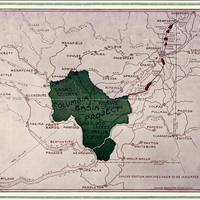Columbia Basin Project, (1925)
Title
Columbia Basin Project, (1925)
Subject
Irrigation -- Washington (State) -- Columbia River Valley -- Maps <br>Columbia Basin Irrigation Project (U.S.)
Description
1 map: col., 18 x 21 cm. <br>Before the arrival to Washington State of the first irrigation projects handled by the U.S. Reclamation Service, the Northern Pacific Railroad and other railway companies funded private irrigation projects in the Columbia River Basin. Their efforts stemmed from a desire to see the entire state in top production and farming communities everywhere in need of railroad shipping services. This map shows the Inland Empire and more importantly, the Columbia Basin Irrigation Project at one of its most crucial times of development. The Inland Empire consisted of eastern Washington, northern Idaho, and northeast Oregon from between the Cascade Mountains to the Rocky Mountains. Within it lay "Big Bend" country--the region farmers flocked to when Palouse land was no longer available. (On this map it is shaded a dark green) For this reason, Big Bend was also known as the "Empire within an Empire". It held some 2,800,000 acres, of which half were irrigable, lying ninety miles from north to south and sixty miles east to west. The project was much too large for one railroad company or town, or other private investor to take handle. By 1919, a number of government agencies (both state and federal) reviewed irrigation plans for the area. Among the top three were the "Gravity Plan", pushed by the city of Spokane and the Washington Water Power Company, the "Pumping Plan" proposed by Billy Clapp of Ephrata and supported by the surveys of Mr. James O'Sullivan, and the "Wenatchee Lake Plan", originating with Wenatchee Valley booster, Mr. Rufus Woods and taken on by the Quincy Valley Water Users Association. The Wenatchee Lake Plan proposed a gravity canal built from Wenatchee Lake in the mountains down to the floor of the Quincy Valley and would only water 400,000 acres. The Pumping Plan involved the erection of a dam at Grand Coulee, giving water to an estimated 1,400,000 acres in the Big Bend country to its south. This map supported the Gravity Plan, which would build a low masonry dam on Pend Oreille River at Albeni Falls, Idaho and hold the waters at Pend Oreille Lake and Priest Lake, Idaho. The reservoir lay approximately forty miles from Spokane. The water would then be sent (by gravity) through a series of canals and tunnels, siphons and aqueducts--even lakes--until it reached the Big Bend country 130 miles below. This plan predicted water for the most amount of acres (1, 750,000) and was touted as economically feasible. Throughout the 1920s, a number of survey reports weighing the feasibility of both plans were given, and approved the gravity plan over the pumping plan. However, the Corps of Engineers' "308 Report" compiled by Major John S. Butler, was the first to approve of the Grand Coulee (pumping plan) venture. When used as evidence in the House of Representative's hearing by the Committee on Irrigation and Reclamation, the tide had changed and the pumping plan was approved over the gravity plan. With this approval, in 1933 President Roosevelt signed for appropriation of funds made possible by the National Industrial Recovery Act and construction on the Grand Coulee Dam began soon after. <br>Shaded portion indicates area to be irrigated.
Creator
Columbia Basin Irrigation League
Source
Manuscripts, Archives, and Special Collections, WSU Libraries
Publisher
Spokane: Dyer Printing Co.
Date
1925
Contributor
Manuscripts, Archives, and Special Collections
Rights
Contact Manuscripts, Archives, and Special Collections, for copyright information 509 335-6691
Relation
Is part of Program, Fourth Annual Convention of the Columbia Basin Irrigation League found in J. Orin Oliphant Papers; Cage 563, Folder 104<br> http://www.wsulibs.wsu.edu/holland/masc/finders/cg563.htm
Format
image/jpeg
Language
English
Type
Maps
Identifier
wsu 477<br>J. Orin Oliphant Papers; Cage 563, Folder 104
Coverage
United States--Washington (State)
Collection
Citation
Columbia Basin Irrigation League, “Columbia Basin Project, (1925),” Digital Exhibits, accessed November 25, 2024, http://752800.40daj.group/items/show/1957.
